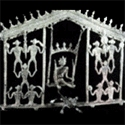Metal-casting is done by the community of nomadic craftsmen called malhores who move from place to place collecting old brass scrap and casting images of gods and goddesses and other items such as diyas, anklets, and bells worn by tribals These metal smiths not only make vessels but also the tools for other artisans. The tribal communities engaged in blacksmithy in the Chhota Nagpur area are the Asur Birja tribals, who are said to be the oldest inhabitants of the area. Isolated from modern influences they continue to fashion folk deities and other articles that draw their inspiration from nature. They obtain the raw material from smelting ore taken from the hills or from melting scrap. The Asurs supply the tools needed for hunting, house construction, and cultivation. The shaping is done by hammering the sheet metal or ingot while heating or by pouring into clay or wax moulds. They use brass, an alloy of zinc and copper, and panchdhatu (five elements), an alloy of copper, zinc, gold, silver, and lead, along with bell-metal, an alloy of tin and copper which has a soft tint of old gold.
Two distinct types of products made in brass ware and bell-metal these days are cast pots and bowls with the lower half black or a natural dark colour, and dhokra articles, mostly figures of riders and elephants, pradip (candle stands), and the fish type of sindhurdan (vermilion box) made by the cire-perdue or lost wax process.
The flexible brass and silver fish made by a goldsmith community concentrated at Haveli Kharagpur in Monghyr district deserves special mention.
Gallery
YOUR VIEWS
PRACTITIONERS: INDIA
Access 70,000+ practitioners in 2500+ crafts across India.
BIBLIOGRAPHY
10,000+ listings on arts, crafts, design, heritage, culture etc.
GLOSSARY
Rich and often unfamiliar vocabulary of crafts and textiles.
SHOP at India InCH
Needs to be written.






